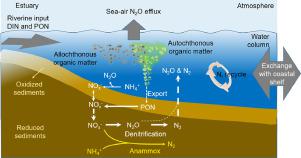Water Research ( IF 11.4 ) Pub Date : 2022-09-14 , DOI: 10.1016/j.watres.2022.119121 Ehui Tan , Ting-Chang Hsu , Wenbin Zou , Xiuli Yan , Zhixiong Huang , Bin Chen , Yongkai Chang , Zhenzhen Zheng , Liwei Zheng , Min Xu , Li Tian , Shuh-ji Kao

|
Sedimentary denitrification and anaerobic ammonium oxidation (anammox) are two microbially-mediated nitrogen removal pathways with distinct climatic feedbacks. Estuaries receive large fluxes of anthropogenic nitrogen and serve as hotspots for nitrogen loss. Applying 15N isotope pairing technique and sediment intact core incubation in two subtropical estuaries, the Yangtze River Estuary (YRE) and Jiulong River Estuary (JRE), we show that denitrification predominates the sedimentary nitrogen loss with a minor contribution (8.6 ± 7.5%) from anammox. Particulate organic matter degradation sustains the sedimentary nitrogen removal linking the nitrogen transformations between water column and sediment. Our results indicate that estuarine sediments exhibit high areal nitrogen removal rate, but play a relatively weak role in eliminating the nitrogen inputted from river basin due to the limited area. The riverine excess nitrogen will eventually enter into the adjacent continental shelf and be removed via phytoplankton assimilation-sedimentation-degradation-coupled nitrification-denitrification. In addition, sedimentary denitrification causes 1.8 ± 2.2% of nitrogen flow towards nitrous oxide (N2O) production and the derived N2O release flux accounts for 59% and 65% of the daily sea-air N2O emission in the YRE and JRE, respectively. These findings contribute to a better understanding of estuarine sedimentary nitrogen removal and associated climate feedbacks, and to the parameterization of Earth system models.
中文翻译:

定量解读两个亚热带河口沉积物脱氮在环境和气候反馈中的作用
沉积反硝化和厌氧氨氧化(anammox)是两种微生物介导的脱氮途径,具有不同的气候反馈。河口接收大量的人为氮,成为氮流失的热点。申请15在长江口(YRE)和九龙江口(JRE)两个亚热带河口(YRE)和九龙江口(JRE),N同位素配对技术和沉积物完整核心孵化,我们表明反硝化作用在沉积氮损失中占主导地位,厌氧氨氧化酶的贡献很小(8.6±7.5%) . 颗粒有机物降解维持了将水柱和沉积物之间的氮转化联系起来的沉积氮去除。我们的研究结果表明,河口沉积物具有较高的面积脱氮率,但由于面积有限,对去除流域输入的氮的作用相对较弱。河流过量的氮最终将进入邻近的大陆架,并通过浮游植物同化-沉淀-降解-耦合硝化-反硝化作用被去除。此外,2 O) 产量和衍生的 N 2 O 释放通量分别占YRE 和 JRE每日海气 N 2 O 排放量的 59% 和 65% 。这些发现有助于更好地理解河口沉积氮的去除和相关的气候反馈,并有助于地球系统模型的参数化。











































 京公网安备 11010802027423号
京公网安备 11010802027423号